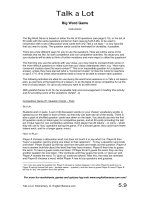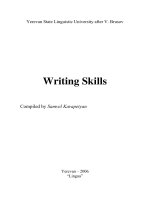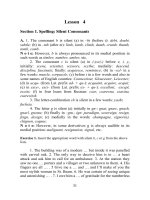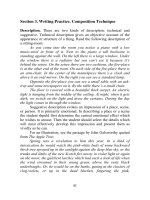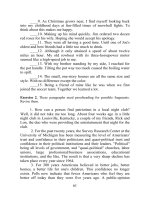Tài liệu Developing writting skills 2 part 7 docx
Bạn đang xem bản rút gọn của tài liệu. Xem và tải ngay bản đầy đủ của tài liệu tại đây (205.45 KB, 10 trang )
60
way immersion in Japanese, which began three years ago in a
Eugene, Ore., elementary school has spread to Portland, Anchorage,
and Detroit. And the French Program at Sunset Elementary School in
Coral Gables, Fla., recently received a grant from the French
government.
9. Being a stranger in a strange land is never easy. “All the
English-speaking kids should learn a foreign language. Then they’d
know how hard it is for us sometimes,” says 17-year-old Sufyan
Kabba, a Maryland high-school junior, who left Sierra Leone last
year. But here they are, part of the nation’s future, young Yankees
who in the end must rely on the special strength of children:
adaptability.
Explain what is meant by:
1. In small towns and big cities, children with names like
Oswaldo, Suong, Boris or Ngam are swelling the rolls
in U.S. public schools…
2. How to teach in a tower of Babel? How is the Tower Of
Babel connected with the main topic of the article?
3. Proponents say that even with bilingual education it
takes between four and seven years for a non-native to
reach national norms on standardized tests.
4. It’s not economically feasible to hire bilingual teachers
unless there are 20 or more students who speak the same
language in the same grade.
5. What does the abbreviation ESL stand for?
QUESTIONS FOR STUDY AND DISCUSSION.
1. What facts are exposed in the article to support the points
raised?
2. What teaching methods are recommended? Which one do
you think is more efficient? Explain why.
3. What problems did the schools face?
61
4. What indication did the author mention to prove that one of
the methods did not work? Do you consider the indication
appropriate?
EXPAND YOUR VOCABULARY
Match the words in Column A with their definitions in Column B.
1) To quiz a) a good standard of ability and
skill
2) Swell b) that is possible and likely to be
achieved
3) Estimate c) to arrange for yourself or for sb
else to officially join a course,
school, etc
4) Proficiency d) something that you can choose
to have or do; the freedom to
choose what you do
5) Proponent e) to care for and protect sb/sth
while they are growing and
developing
6) Feasible f) Put into water, involve deeply
7) Dropout g) a person who supports an idea or
course of action
8) Option h) to form an idea of the cost, size,
value etc. of sth, but without
calculating it exactly
9) Nurture i) a person who leaves school or
college before he has finished
his studies
10) Enroll j) to ask someone a lot of
questions (to check general
knowledge)
11) immerse k) to become greater in volume
62
YOUR TURN
1. Visit the Yerevan State University or the Medical University
where a significant number of foreign students from Iran,
India, and Syria study. Interview some of them to find out
what difficulties, if any, they have in adapting to their new
lifestyle in Armenia. Write an essay on the topic using the
outcome of your interview as supporting sentences.
2. Find out how your peers who are married and have children
manage to combine family life with university life.
Tips for Successful Writing
Concluding Paragraphs
A good conclusion should fit with the introduction like two
pieces of a jigsaw puzzle. In other words, the conclusion should tie
together what you have said just as the introduction interested the
reader in what was to come. The conclusion finalizes the essay,
drawing it to a close.
The concluding paragraph has two functions. Its first function
is to provide a short summary of the main points by restating the
thesis statement in different words. It also can have a final thought-
provoking statement or comment on the subject you discussed, so
that the reader is encouraged to explore it or think about it further.
As with the other parts of the essay, the conclusion may be
developed in a number of ways, and these ways may also be
combined. Once you have paraphrased your specific points, you
may, for example, want to:
1. write two or three more general statements on the subject as
a whole;
63
2. finish off with a thought provoking statement or question;
3. comment on the future, or make
predictions about possible
outcomes;
4. offer advice; make a call to action;
5. close with a statement or quotation readers will remember;
6. respond to a question in your introduction.
Note:
Always re-read your introduction before you start writing the
concluding paragraph.
Avoid repeating every key point you wrote in the essay,
changing your point of view, bringing in new ideas, or sounding
unsure of yourself.
64
TEXT 3
Doctor Shanna
- Can any living being get education?
- What are the necessary steps to get
higher education?
- Have you heard of “Diploma Mills”?
- How do they operate?
As you read the following text try to
find the answers to these and to some other
questions.
1. Almost all of the colleges in this country can be regarded as
respectable institutions. In return for tuition money, they offer a
variety of useful courses and, ultimately, a degree for those who
qualify. There are a few colleges, however, that operate in a shady
manner, providing degrees to which people are not entitled, for
courses that they never took. One of the most notorious in recent
years was Pacific College in Los Angeles, California, sometimes
called “the dropouts’ Harvard.”
2. To illustrate how easy it was to get an advanced degree from
such “diploma mills,” New York legislator Leonard Stavisky
enrolled his German shepherd, Shanna, at Pacific College. “Ms.
Shanna Stavisky” presumably sent his admission fee of $150 and by
return mail received a breezy letter from “Dean Ashby” that read,
“Your talent and experience are going to be recognized sooner or
later. Welcome, my friend, to Pacific College.”
3. Shanna was placed in a Ph.D. program in “recreation
management.” “That is very appropriate,” joked Mr. Stavisky, “since

